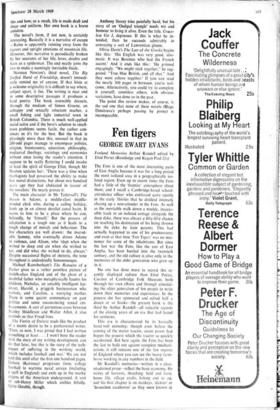Fen tigers
GEORGE EWART EVANS
Fenland Memories Arthur Randell edited by Enid Porter (Routledge and Kegan Paul 21s) The Fens is one of the most interesting parts of East Anglia because it was for a long period the most isolated area in a geographically iso- lated region. Even up to recent times the Fens had a little of the 'frontier' atmosphere about them; and I recall a Cambridge-based school- attendance officer who confessed quite openly in the early 'thirties that he disliked intensely chasing up a non-attender in the Fens. As well as the inevitable walk down a muddy, inacces- sible track to an isolated cottage alongside the deep dyke, there was always a fifty-fifty chance on reaching his destination of his being thrown into the dyke by irate parents. This had actually happened to one of his predecessors; and even at that time 'Fen Tigers' was no mis- nomer for some of the inhabitants. But since the last war the Fens, like the rest of East Anglia, has been hustled into the twentieth century, and the old culture is alive only in the memories of the older generation who grew up in it.
No one has done more to record this re- cently displayed culture than Enid Porter, Curator of Cambridge Folk Museum, both through her own efforts and through stimulat- ing the older generation of fen people to write down their memories and experiences. In the process she has sponsored and edited half a dozen or so books—the present book is the third by Arthur Randell—all valuable records of the closing years of an era that had lasted for centuries.
This era is characterised by its basically hand-tool economy; though even before the coming of the motor tractor, steam power had begun the process which the tractor so quickly accelerated. But here again, the Fens has been the last to hold out against complete mechani- sation; it still remains one of the few regions of England where you can see the heavy farm- horse working in any numbers in the field.
Mr Randell's memories—written in a clear. unadorned prose—reflect the basic economy. He writes of harvests, threshing. field and farm, home life, village crafts, fishing and so op; and his first chapter is on donkeys, 'dickies' or 'Jerusalem racehorses' as they were known in the dialect. Yet the donkey was more than just a marginal figure of amusement: it was part of the fen way of life, used for transport and also for cultivation, as one of the book's excellent photographs shows. The donkey was trained to the plough: he was the poor man's Punch or Percheron, as essential to the cot- tage economy (to which most of the folk-life of the Fens was closely linked) as the heavy horse was to the big farmer before the coming of the tractor.
Apart from the immediate enjoyment a reader will get from Mr Randell's clearly etched memories, they are of obvious value as a record, preserving the unspectacular minutiae of a way of life that is already historic. Sir George Stapledon wrote in his last book that, now the old methods of farming have become obsolete, students of English will be hard put to comprehend a large area of our literature simply because the farm and the rural scene as it is today are no longer handy terms of reference. It is books such as the present one that will help supply the missing background material. They will show, for instance, that language and words are closely linked to a regional economy. Here is an example from Mr Randell's book : 'boots' in the Fens were the knee- or thigh-length boots necessary for men whose work was largely concerned with draining and fishing. Boots, as we now know them, were called 'shoes,' and our shoes were called rather patronisingly 'ankle-jacks.' The same need to distinguish between boots (high boots) and the other variety .induced men of the old community in East Suffolk to coin the splendidly descriptive word 'highlows.'



































 Previous page
Previous page